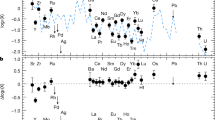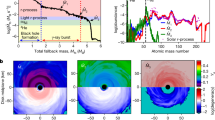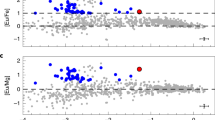Abstract
Elements heavier than zinc are synthesized through the rapid (r) and slow (s) neutron-capture processes1,2. The main site of production of the r-process elements (such as europium) has been debated for nearly 60 years2. Initial studies of trends in chemical abundances in old Milky Way halo stars suggested that these elements are produced continually, in sites such as core-collapse supernovae3,4. But evidence from the local Universe favours the idea that r-process production occurs mainly during rare events, such as neutron star mergers5,6. The appearance of a plateau of europium abundance in some dwarf spheroidal galaxies has been suggested as evidence for rare r-process enrichment in the early Universe7, but only under the assumption that no gas accretes into those dwarf galaxies; gas accretion8 favours continual r-process enrichment in these systems. Furthermore, the universal r-process pattern1,9 has not been cleanly identified in dwarf spheroidals. The smaller, chemically simpler, and more ancient ultrafaint dwarf galaxies assembled shortly after the first stars formed, and are ideal systems with which to study nucleosynthesis events such as the r-process10,11. Reticulum II is one such galaxy12,13,14. The abundances of non-neutron-capture elements in this galaxy (and others like it) are similar to those in other old stars15. Here, we report that seven of the nine brightest stars in Reticulum II, observed with high-resolution spectroscopy, show strong enhancements in heavy neutron-capture elements, with abundances that follow the universal r-process pattern beyond barium. The enhancement seen in this ‘r-process galaxy’ is two to three orders of magnitude higher than that detected in any other ultrafaint dwarf galaxy11,16,17. This implies that a single, rare event produced the r-process material in Reticulum II. The r-process yield and event rate are incompatible with the source being ordinary core-collapse supernovae18, but consistent with other possible sources, such as neutron star mergers19.
This is a preview of subscription content, access via your institution
Access options
Subscribe to this journal
Receive 51 print issues and online access
$199.00 per year
only $3.90 per issue
Buy this article
- Purchase on Springer Link
- Instant access to full article PDF
Prices may be subject to local taxes which are calculated during checkout


Similar content being viewed by others
References
Sneden, C., Cowan, J. J. & Gallino, R. Neutron-capture elements in the early galaxy. Annu. Rev. Astron. Astrophys. 46, 241–288 (2008)
Burbidge, E. M., Burbidge, G. R., Fowler, W. A. & Hoyle, F. Synthesis of the elements in stars. Rev. Mod. Phys. 29, 547–650 (1957)
Qian, Y. Z. Supernovae versus neutron star mergers as the major r-process sources. Astrophys. J. 534, L67–L70 (2000)
Argast, D., Samland, M., Thielemann, F. K. & Qian, Y. Z. Neutron star mergers versus core-collapse supernovae as dominant r-process sites in the early Galaxy. Astron. Astrophys. 416, 997–1011 (2004)
Tanvir, N. R. et al. A ‘kilonova’ associated with the short-duration γ-ray burst GRB 130603B. Nature 500, 547–549 (2013)
Wallner, A. et al. Abundance of live 244Pu in deep-sea reservoirs on Earth points to rarity of actinide nucleosynthesis. Nature Commun . 6, 5956 (2015)
Tsujimoto, T., Ishigaki, M. N., Shigeyama, T. & Aoki, W. Chemical feature of Eu abundance in the Draco dwarf spheroidal galaxy. Publ. Astron. Soc. Jpn 67, L3 (2015)
Kirby, E. N., Lanfranchi, G. A., Simon, J. D., Cohen, J. G. & Guhathakurta, P. Multi-element abundance measurements from medium-resolution spectra. III. Metallicity distributions of Milky Way dwarf satellite galaxies. Astrophys. J. 727, 78 (2011)
Burris, D. L. et al. Neutron-capture elements in the early galaxy: insights from a large sample of metal-poor giants. Astrophys. J. 544, 302–319 (2000)
Ji, A. P., Frebel, A. & Bromm, V. Preserving chemical signatures of primordial star formation in the first low-mass stars. Mon. Not. R. Astron. Soc. 454, 659–674 (2015)
Frebel, A., Simon, J. D. & Kirby, E. N. Segue 1: an unevolved fossil galaxy from the early Universe. Astrophys. J. 786, 74 (2014)
Bechtol, K. et al. Eight new Milky Way companions discovered in first-year Dark Energy Survey data. Astrophys. J. 807, 50 (2015)
Koposov, S. E., Belokurov, V., Torrealba, G. & Evans, N. W. Beasts of the southern wild: discovery of nine ultra faint satellites in the vicinity of the Magellanic Clouds. Astrophys. J. 805, 130 (2015)
Simon, J. D. et al. Stellar kinematics and metallicities in the ultra-faint dwarf galaxy Reticulum II. Astrophys. J. 808, 95 (2015)
Roederer, I. U. et al. Detailed chemical abundances in the r-process-rich ultra-faint dwarf galaxy Reticulum 2. Preprint at http://arxiv.org/pdf/1601.04070.pdf (2016)
Ji, A. P., Frebel, A., Simon, J. D. & Geha, M. C. High-resolution spectroscopy of extremely metal-poor stars in the least evolved galaxies: Bootes II. Astrophys. J. 817, 41 (2016)
François, P. et al. Abundance ratios of red giants in low mass ultra faint dwarf spheroidal galaxies. Preprint at arXiv:1510.05401 (2015)
Wanajo, S. The r-process in proto-neutron-star Wind revisited. Astrophys. J. 770, L22 (2013)
Goriely, S., Bauswein, A. & Janka, H.-T. R-process nucleosynthesis in dynamically ejected matter of neutron star mergers. Astrophys. J. 738, L32 (2011)
Brown, T. M. et al. The quenching of the ultra-faint dwarf galaxies in the reionization era. Astrophys. J. 796, 91 (2014)
Kirby, E. N., Simon, J. D., Geha, M. C., Guhathakurta, P. & Frebel, A. Uncovering extremely metal-poor stars in the Milky Way’s ultrafaint dwarf spheroidal satellite galaxies. Astrophys. J. 685, L43–L46 (2008)
Dominik, M. et al. Double compact objects. I. The significance of the common envelope on merger rates. Astrophys. J. 759, 52 (2012)
Wehmeyer, B., Pignatari, M. & Thielemann, F. K. Galactic evolution of rapid neutron capture process abundances: the inhomogeneous approach. Mon. Not. R. Astron. Soc. 452, 1970–1981 (2015)
Frebel, A. Stellar archaeology: exploring the Universe with metal-poor stars. Astron. Nachr. 331, 474–488 (2010)
Komiya, Y., Yamada, S., Suda, T. & Fujimoto, M. Y. The new model of chemical evolution of r-process elements based on the hierarchical galaxy formation. I. Ba and Eu. Astrophys. J. 783, 132 (2014)
Shen, S. et al. The history of r-process enrichment in the Milky Way. Astrophys. J. 807, 115 (2015)
Van de Voort, F., Quataert, E., Hopkins, P. F., Kere, D. & Faucher-Giguere, C. A. Galactic r-process enrichment by neutron star mergers in cosmological simulations of a Milky Way-mass galaxy. Mon. Not. R. Astron. Soc. 447, 140–148 (2014)
Ishimaru, Y., Wanajo, S. & Prantzos, N. Neutron star mergers as the origin of r-process elements in the galactic halo based on the sub-halo clustering scenario. Astrophys. J. 804, L35 (2015)
Bland-Hawthorn, J., Sutherland, R. & Webster, D. Ultrafaint dwarf galaxies—the lowest-mass relics from before reionization. Astrophys. J. 807, 154 (2015)
Frebel, A. & Bromm, V. Chemical signatures of the first galaxies: criteria for one-shot enrichment. Astrophys. J. 759, 115 (2012)
Walker, M. G. et al. Magellan/M2FS spectroscopy of the Reticulum 2 dwarf spheroidal galaxy. Astrophys. J. 808, 108 (2015)
Koposov, S. E. et al. Kinematics and chemistry of recently discovered Reticulum 2 and Horologium 1 dwarf galaxies. Astrophys. J. 811, 62 (2015)
Bernstein, R., Shectman, S. A., Gunnels, S. M., Mochnacki, S. & Athey, A. E. MIKE: a double echelle spectrograph for the Magellan telescopes at Las Campanas Observatory. Proc. SPIE 4841, 1694–1704 (2003)
Kelson, D. D. Optimal techniques in two-dimensional spectroscopy: background subtraction for the 21st century. Publ. Astron. Soc. Pacif . 115, 688–699 (2003)
Casey, A. R. A tale of tidal tails in the Milky Way. Preprint at arXiv:1405.5968 (2014)
Frebel, A., Casey, A. R., Jacobson, H. R. & Yu, Q. Deriving stellar effective temperatures of metal-poor stars with the excitation potential method. Astrophys. J. 769, 57 (2013)
Castelli, F. & Kurucz, R. L. New grids of ATLAS9 model atmospheres. Preprint at arXiv:astro-ph/0405087 (2004)
Sneden, C. A. Carbon and Nitrogen Abundances in Metal-Poor Stars. PhD thesis, Univ. Texas, Austin (1973)
Kim, Y. C., Demarque, P., Yi, S. K. & Alexander, D. R. The Y2 isochrones for α-element enhanced mixtures. Astrophys. J . 143 (Suppl.), 499–511 (2002)
Hill, V. et al. First stars. I. The extreme r-element rich, iron-poor halo giant CS 31082-001. Implications for the r-process site(s) and radioactive cosmochronology. Astron. Astrophys. 387, 560–579 (2002)
Ivans, I. I. et al. Near-ultraviolet observations of HD 221170: new insights into the nature of r-process-rich stars. Astrophys. J. 645, 613–633 (2006)
Sneden, C., Lawler, J. E., Cowan, J. J., Ivans, I. I. & Den Hartog, E. A. New rare earth element abundance distributions for the Sun and five r-process-rich very metal-poor stars. Astrophys. J . 182 (Suppl.), 80–96 (2009)
Roederer, I. U. et al. A search for stars of very low metal abundance. VI. Detailed abundances of 313 metal-poor stars. Astrophys. J. 147, 136 10.1088/0004-6256/147/6/136 (2014)
Keeping, E. S. Introduction to Statistical Inference Ch. 8 (Van Nostrand, 1962)
Asplund, M., Grevesse, N., Sauval, A. J. & Scott, P. The chemical composition of the Sun. Annu. Rev. Astron. Astrophys. 47, 481–522 (2009)
Greif, T. H., Glover, S. C. O., Bromm, V. & Klessen, R. S. The first galaxies: chemical enrichment, mixing, and star formation. Astrophys. J. 716, 510–520 (2010)
McConnachie, A. W. The observed properties of dwarf galaxies in and around the local group. Astrophys. J. 144, 4 10.1088/0004-6256/144/1/4 (2012)
Dotter, A. et al. The Dartmouth stellar evolution database. Astrophys. J . 178 (Suppl.), 89–101 (2008)
Geha, M. C. et al. The stellar initial mass function of ultra-faint dwarf galaxies: evidence for IMF variations with galactic environment. Astrophys. J. 771, 29 (2013)
Abadie, J. et al. Topical review: predictions for the rates of compact binary coalescences observable by ground-based gravitational-wave detectors. Class. Quantum Gravity 27, 173001 (2010)
Bramante, J. & Linden, T. On the r-process enrichment of dwarf spheroidal galaxies. Preprint at arXiv:1601.06784 (2016)
Acknowledgements
We gathered data using the 6.5-metre Magellan Clay telescope located at Las Campanas Observatory, Chile. A.P.J. thanks N. Weinberg and P. Schechter for discussions. A.P.J. and A.F. are supported by National Science Foundation (NSF)-CAREER grant AST-1255160. A.F. acknowledges support from the Silverman (1968) Family Career Development Professorship. J.D.S. acknowledges support from NSF grant AST-1108811. This work made use of NASA’s Astrophysics Data System Bibliographic Services and the open-source Python libraries numpy, scipy, matplotlib, statsmodels, pandas, seaborn, and astropy. We also used data products originally obtained with the Dark Energy Camera (DECam), which was constructed by the Dark Energy Survey (DES) collaboration. The DES Projects have been funded by the DOE and the NSF (USA), MISE (Spain), STFC (UK), HEFCE (UK), NCSA (UIUC), KICP (Univ. Chicago), CCAPP (Ohio State), MIFPA (Texas A&M), CNPQ, FAPERJ and FINEP (Brazil), MINECO (Spain), DFG (Germany) and the collaborating institutions in the Dark Energy Survey, which are Argonne Lab, UC Santa Cruz, University of Cambridge, CIEMAT-Madrid, University of Chicago, University College London, DES-Brazil Consortium, University of Edinburgh, ETH Zürich, Fermilab, University of Illinois, ICE (IEEC-CSIC), IFAE Barcelona, Lawrence Berkeley Lab, LMU München and the associated Excellence Cluster Universe, University of Michigan, NOAO, University of Nottingham, Ohio State University, University of Pennsylvania, University of Portsmouth, SLAC National Lab, Stanford University, University of Sussex, and Texas A&M University.
Author information
Authors and Affiliations
Contributions
A.P.J. took the observations and led the analysis and paper writing; A.F. and A.C. assisted with the observations; A.F. and J.D.S. contributed to the analysis; all authors contributed to writing the paper.
Corresponding author
Ethics declarations
Competing interests
The authors declare no competing financial interests.
Extended data figures and tables
Extended Data Figure 1 Properties of Reticulum II member stars.
a, Coordinates of member stars, in right ascension (RA) and declination (DEC) at the standard epoch (J2000)14. Stars selected for observation with high-resolution spectroscopy are highlighted with large coloured circles, while other members are shown in black. b, Colour–magnitude diagram based on Dark Energy Survey photometry14; g and r are the stars’ magnitudes in two different filters.
PowerPoint slides
Rights and permissions
About this article
Cite this article
Ji, A., Frebel, A., Chiti, A. et al. R-process enrichment from a single event in an ancient dwarf galaxy. Nature 531, 610–613 (2016). https://doi.org/10.1038/nature17425
Received:
Accepted:
Published:
Issue Date:
DOI: https://doi.org/10.1038/nature17425
This article is cited by
-
Possibilities of identifying members from Milky Way satellite galaxies using unsupervised machine learning algorithms
Journal of Astrophysics and Astronomy (2024)
-
Heavy elements
Experimental Astronomy (2023)
-
Chemical and stellar properties of early-type dwarf galaxies around the Milky Way
Nature Astronomy (2022)
-
Forward-looking insights in laser-generated ultra-intense γ-ray and neutron sources for nuclear application and science
Nature Communications (2022)
-
Response functions of a 4π summing gamma detector in β-Oslo method
Nuclear Science and Techniques (2022)
Comments
By submitting a comment you agree to abide by our Terms and Community Guidelines. If you find something abusive or that does not comply with our terms or guidelines please flag it as inappropriate.



